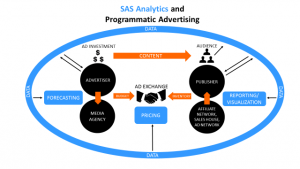 Once upon a time, the only way to buy and sell advertising inventory was based on the relationship between advertiser and publisher. The exchange was manual, with advertisers paying publishers an agreed-upon price for every impression. The process involved a lot of phone calls, spreadsheets, negotiation and re-negotiation, all of which took a lot of time and effort.
Once upon a time, the only way to buy and sell advertising inventory was based on the relationship between advertiser and publisher. The exchange was manual, with advertisers paying publishers an agreed-upon price for every impression. The process involved a lot of phone calls, spreadsheets, negotiation and re-negotiation, all of which took a lot of time and effort.
Now, there’s another option: Programmatic advertising.
So what is programmatic? It’s the use of software that uses data to inform the buying and selling of advertisements. More specifically, programmatic is the buying of target individuals. How? By using big data to determine the right ad for the right consumer at the right time. Programmatic software allows for automation, to varying degrees, and therefore requires considerably less human effort than the traditional method.
Programmatic has been around the digital sphere for years, but is now evolving towards linear as well. Linear needs data more than ever to make optimal decisions within an emerging technology. It’s within the linear domain that analytics can now make the most impact, with a focus on targeting and workflow automation.
There are various flavors of programmatic buying processes. Here are three of the most common:
- Real-time bidding (RTB)
RTB is the process of buying ads through computer-run, real-time auctions. Many buyers bid on the inventory of many publishers (similar to eBay). The buyer doesn’t know the specific platform on which the ad will be published. This method is the most cost-effective, and offers access to the largest audience, but some say that the quality of inventory is sub-par.
- Private marketplace
A private marketplace is invitation-only, where one or a few publishers invite a select number of buyers to participate in an RTB or direct exchange. The buyer knows exactly where their ad will be published. This method typically involves only premium inventory.
- Programmatic direct
Programmatic direct refers to the use of software that allows advertisers to buy guaranteed impressions from specific publishers. The process is automated, so it requires little human intervention. A publisher’s sales representative might make an agreement with an advertiser that includes premium inventory at a fixed price for a specific number of impressions.This subsection of programmatic can be compared to purchasing a flight from an airline’s own website instead of searching for the best rate on Google flights, hence the term “direct”. This method caters to advertisers who prioritize brand integrity and inventory control.
Where does big data come in? Data analytics can drastically improve programmatic advertising, reducing reach waste and increasing ROI throughout the process, particularly in these areas:
Data and storage
It’s imperative to make sense of the massive datasets available. Demographic data, publisher data, third party data, and other datasets can all be stored and utilized to inform better purchasing decisions, but they need to be cleaned and organized first. Real-time data quality integration can cleanse data as it’s being moved, replicated, or synchronized.
A library of reusable business rules can reduce the human effort necessary for each sell. This data must be analyzed and delivered in a way that allows users to see what’s happening in real time, as well as the actions that should be taken in response. Programmatic players don’t have to physically store this data -- they can keep it in the cloud using services such as Amazon Web Services or Azure.
Forecasting
To manage their ad inventory, publishers must be able to accurately forecast how many people will visit a website or watch a television show. Publishers also need to make decisions on how to best allocate inventory to programmatic advertising versus direct advertising, which is virtually impossible to do without analytics.
Inventory modeling can model the diminishing returns for each type of inventory, among other functions. Other helpful capabilities include hierarchical forecasting and what-if scenario analysis. These capabilities and others would allow publishers to accurately forecast impressions, audiences, and campaign specific targets, including seasonal variations in programming and the monetization of inventory.
Pricing
To optimize the pricing of programmatic inventory, the analytics must be able to factor in market changes in real time. With analytics, large pieces of data can be optimized to come up with a price that works for both the buyer and the seller of an impression.
In addition, automated task management can be configured so that any new data sets will be used when re-running allocations, optimization, forecasting, and other capabilities. This will allow sellers to greatly reduce redundancies and the labor of inventory allocation.
Reporting and visualization
Using performance analytics to measure and depict how campaigns actually perform against expectations can provide invaluable insight into what’s working within a programmatic strategy and what isn’t. Reporting and visualization capabilities can help business people quickly make sense of complex data.
 Next steps
Next steps
The advertising world is evolving rapidly. Advertisers need to make the most of their ad spend and publishers need to allocate inventory efficiently. Both parties need to increase their bottom line by using data analytics to make data-driven decisions. SAS provides the wide array of the capabilities necessary at each step to streamline and optimize the programmatic advertising process. The power of SAS-enabled programmatic advertising insights could be the difference between making the sale, or not.
Check out the SAS Media Analytics page to explore what SAS can do with audience data, or read how one customer is doing more with advertising data, using SAS Intelligent Advertising.
